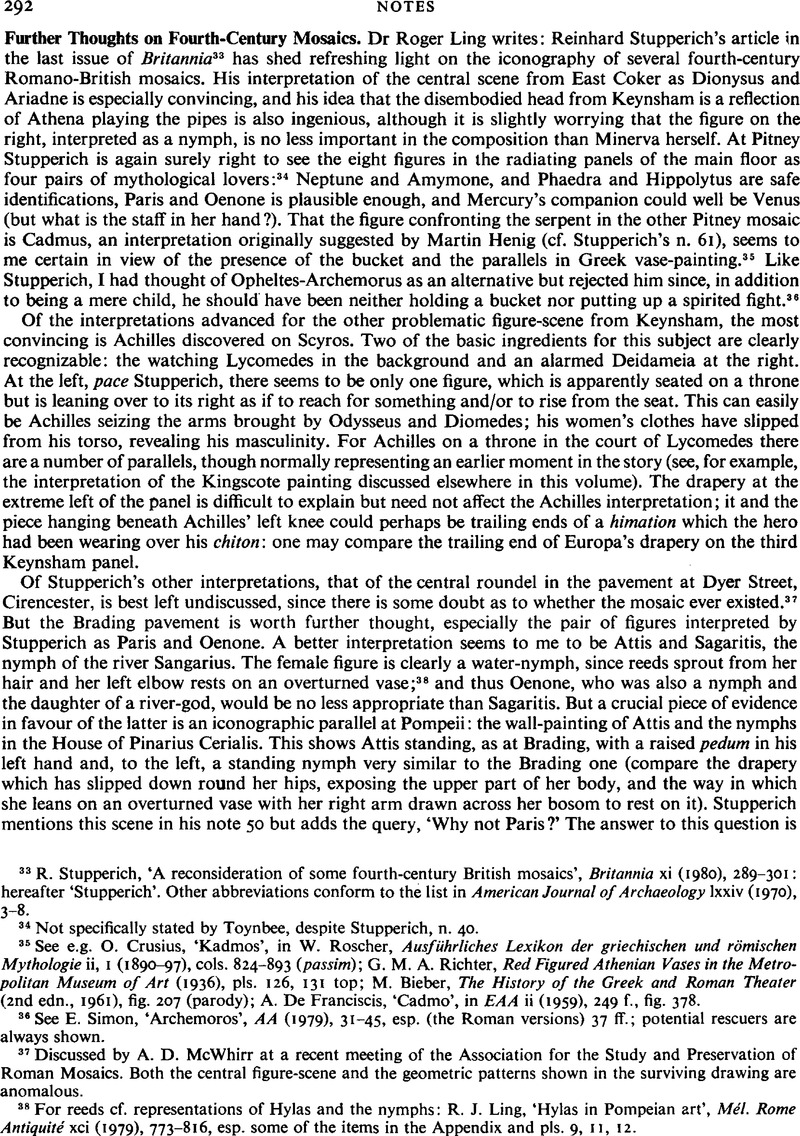Article contents
Further Thoughts on Fourth-Century Mosaics
Published online by Cambridge University Press: 09 November 2011
Abstract

- Type
- Notes
- Information
- Copyright
- Copyright © Dr Roger Ling 1981. Exclusive Licence to Publish: The Society for the Promotion of Roman Studies
References
33 Stupperich, R., ‘A reconsideration of some fourth-century British mosaics’, Britannia xi (1980), 289–301CrossRefGoogle Scholar: hereafter ‘Stupperich’. Other abbreviations conform to the list in American Journal of Archaeology lxxiv (1970), 3–8.Google Scholar
34 Not specifically stated by Toynbee, despite Stupperich, n. 40.
35 See e.g. Crusius, O., ‘Kadmos’, in Roscher, W., Ausführliches Lexikon der griechischen und römischen Mythologie ii, 1 (1890–1897), cols. 824–893Google Scholar (passim); G. M. A. Richter, Red Figured Athenian Vases in the Metropolitan Museum of Art (1936), pls. 126, 131 top; M. Bieber, The History of the Greek and Roman Theater(2nd edn., 1961), fig. 207 (parody); Franciscis, A. De, ‘Cadmo’, in EAA ii (1959), 249 f., fig. 378.Google Scholar
36 See E. Simon, ‘Archemoros’, AA (1979), 31–45, esp. (the Roman versions) 37 ff.; potential rescuers are always shown.
37 Discussed by A. D. McWhirr at a recent meeting of the Association for the Study and Preservation of Roman Mosaics. Both the central figure-scene and the geometric patterns shown in the surviving drawing are anomalous.
38 For reeds cf. representations of Hylas and the nymphs: R. J. Ling, ‘Hylas in Pompeian art’, Mél. Rome Antiquité xci (1979), 773–816, esp. some of the items in the Appendix and pls. 9, 11, 12.
39 On Attis in Pompeian painting see V. Spinazzola, Pompei alla luce degli scavi nuovi di Via dell'Abbondanza (1953), 702–707; K. Schefold, Vergessenes Pompeji (1962), 114 f., 168–170, pls. 79, 170 (4). For Paris as a shepherd idem, La peinture pompéienne (1972), pl. 25 and p. 259 (with bibl.).
40 Attis with a syrinx: EAA i (1958), 907, fig. 1139.Google Scholar
41 The iconography of Neptune and Amymone is studied in E. Simon's model article (1974) for the forthcoming Lexicon Iconographicum Mythologiae Classicae; a few further items must now be added (e.g. Ling, op. cit. (note 38), 802 and n. 61; Lanckoronski, K. (ed.), Städte Pamphyliens und Pisidiens i (1890), 140 f., fig. 101Google Scholar; BCH xcix (1975), 844 and fig. 67Google Scholar; J.-P. Darmon, Nymfarum Domus (1980), 160–163, pls. xlviii, lxxxii (=Simon, no. 70?).
- 2
- Cited by




